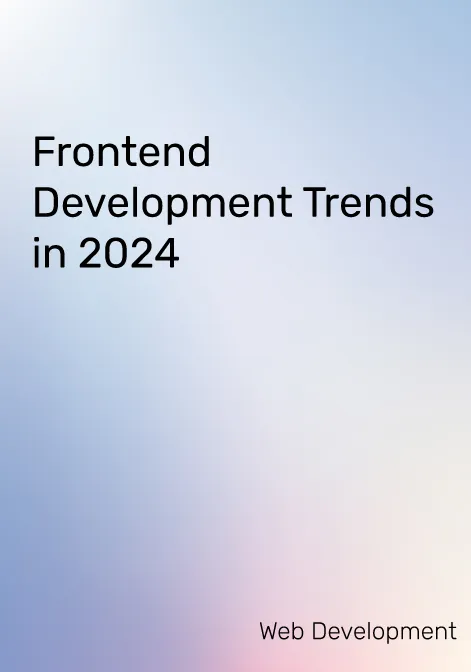Frontend development is a crucial aspect of web development that deals with the user interface and user experience of a website. In recent years, frontend development has undergone significant changes, with new technologies and trends emerging every year. In this article, we will discuss the latest frontend development trends for 2024.
Top Frontend Development Trends
- No Code/Low Code: No Code/Low Code is a trend that has gained popularity in recent years. It allows website developers to create web applications without writing code. Instead, they use visual interfaces to drag and drop components and create applications quickly and easily. This trend is expected to continue in 2024, with more businesses adopting this approach to building web applications.
- Progressive Web Apps: Progressive Web Apps (PWAs) are web applications that provide native app-like experiences for users. They are fast, reliable, and offline. PWAs are built using web technologies such as HTML, CSS, and JavaScript and can be installed on a user’s device like a native app. This trend is expected to continue in 2024, with more businesses adopting PWAs to provide a better user experience.
- Single Page Applications: Single Page Applications (SPAs) are web applications that load a single HTML page and dynamically update it as the user interacts with it. SPAs provide a fast and seamless user experience and are built using JavaScript frameworks such as React, Angular, and Vue.js. This trend is expected to continue in 2024, with more businesses adopting SPAs to provide a better user experience.
- Micro Frontends: Micro Frontends is a trend that involves breaking down a large frontend application into smaller, more manageable pieces. Each piece is developed and deployed independently, allowing for greater flexibility and scalability. This trend is expected to continue in 2024, with more businesses adopting this approach to build web applications.
- Serverless Architecture: Serverless Architecture is a trend that involves building applications without the need for servers. Instead, developers use cloud-based services to run their applications, reducing costs and increasing scalability. This trend is expected to continue in 2024, with more businesses adopting this approach to build web applications.
- Headless CMS: Headless CMS is a trend that involves separating the content management system from the frontend application. This allows developers to use any frontend technology they want while still managing content through a CMS. This trend is expected to continue in 2024, with more businesses adopting this approach to build web applications.
- Low-Code Development: Low-Code Development is a trend that involves using visual interfaces to create applications quickly and easily. It allows developers to focus on the business logic of an application rather than the technical details. This trend is expected to continue in 2024, with more businesses adopting this approach to build web applications.
- Jamstack: Jamstack is a trend that involves building web applications using JavaScript, APIs, and Markup. It provides a fast and secure user experience and is built using modern web technologies. This trend is expected to continue in 2024, with more businesses adopting this approach to build web applications.
- WebAssembly: WebAssembly is a trend that involves running compiled code in the browser. It allows developers to write applications in languages such as C++ and Rust and run them in the browser. This trend is expected to continue in 2024, with more businesses adopting this approach to build web applications.
Other Notable Trends
- Reactive Programming: Reactive Programming is a trend that involves building applications that react to changes in data. It allows developers to build applications that are more responsive and scalable. This trend is expected to continue in 2024, with more businesses adopting this approach to build web applications.
- Focus on UX: Focus on UX is a trend that involves designing applications with the user in mind. It involves creating applications that are easy to use, intuitive, and provide a seamless user experience. This trend is expected to continue in 2024, with more businesses adopting this approach to build web applications.
- Performance Optimization: Performance Optimization is a trend that involves optimizing web applications for speed and performance. It involves techniques such as lazy loading, code splitting, and caching. This trend is expected to continue in 2024, with more businesses adopting this approach to build web applications.
- Collaboration and Teamwork: Collaboration and teamwork is a trend that involves working together to build applications. It involves using tools such as Git and GitHub to collaborate on code and manage projects. This trend is expected to continue in 2024, with more businesses adopting this approach to building web applications.
- Serverless Architecture: Serverless architecture is a trend that involves building applications without servers. Instead, developers use cloud-based services to run their applications, reducing costs and increasing scalability.
Future Trends
- Artificial Intelligence: Artificial Intelligence is a trend that is expected to have a significant impact on frontend development in the coming years. It involves using machine learning algorithms to create intelligent applications that can learn and adapt to user behavior.
- Virtual and Augmented Reality: Virtual and Augmented Reality is a trend that is expected to revolutionize the way we interact with web applications. It involves creating immersive experiences that allow users to interact with applications in new and exciting ways.
- Voice User Interfaces: Voice User Interfaces is a trend that involves using voice commands to interact with web applications. It allows users to interact with applications hands-free and is expected to become more prevalent in the coming years.
Conclusion
frontend development is an ever-evolving field that requires developers to stay up-to-date with the latest trends and technologies. Developers should also be aware of the best practices in the industry to ensure quality code and user experience. Finally, frontend developers should strive to stay creative and think outside the box when developing web applications.




